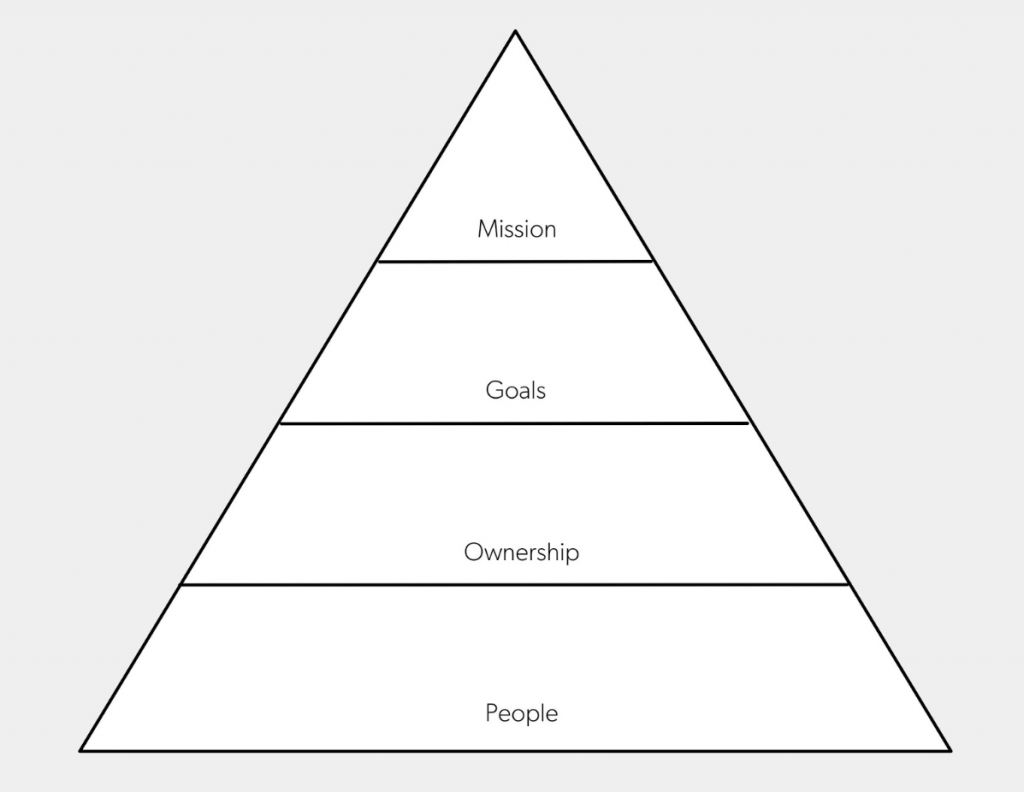 Have ever spoken to someone that works at Google, Airbnb, WeWork, and other disruptive companies and wondered why is the enthusiasm so strong and almost cult-like? It could be motivated by stock options and the chance of cashing in on an IPO, but more times than that it is built and nurtured into the company’s culture and purpose.
Have ever spoken to someone that works at Google, Airbnb, WeWork, and other disruptive companies and wondered why is the enthusiasm so strong and almost cult-like? It could be motivated by stock options and the chance of cashing in on an IPO, but more times than that it is built and nurtured into the company’s culture and purpose.
How do you build and maintain motivation in your startup or growing small business? Keeping your team and employees motivated is something that every executive or entrepreneur should be thinking about. First Round Review wrote up an interesting interview with Jack Chou, who was a former product leader for Linkedin and Pinterest. He has a lot of experience in managing and growing teams. He has few tips on how you learn to spot declining employee purpose or motivation in their daily management interactions and ways to spark inspiration and turn things around.
The 4 key ingredients of motivation
According to Jack Chou, he says that motivation in the workplace or office can be characterized into 4 levels that almost like a pyramid. And each level builds off each other.
 Image credit: First Round Review
Image credit: First Round Review
So the first foundational piece of motivation is the team or department or business unit that a person works with on a day to day basis. When the dynamic of a team comes apart in can usually come down to a few causes. The is could be under-resourced or staffed or having people working together that do not like each other or get along. If you in a team that is feeling pressure to launch a new product or service and stress kicks in to hit targets, nothing can wipe motivation faster than feeling overwhelmed with meeting deadlines. So when there is a team that is tasked with accomplishing a challenging goal does that have enough people working the problem, then it be very hard to stay upbeat and motivated. The second part of team issues is office politics or interpersonal frictions. Chou says “If people don’t like and trust the humans they work with, none of the rest of it matters.” He goes on to note that “If they do — or at the very least respect the skill sets of those other folks, and are able to work with them — now we have something we can build on.”
If you are building a startup or growing a business and the team members are constantly arguing or butting heads about how do you approach something, sometimes it can be solved by simply giving it time. Sometimes people just need to find their rhythm or team dynamic. Sometimes doing team exercises such as white-boarding the problem out for an hour or two can help to build rapport. Sometimes people need to get past formalities. Now if you are trying to achieve growth or scale for your business, time may be of the essence or in short supply. So when you make a new hire to fill a critical role you need, CEOs should put just as much effort into creating a trust-building work environment as they as recruiting the rockstar talent hires. It’s also important for building team morale to put different employees into situations where they have to work together, figure out a problem, brainstorm ideas and come up a viable solution together. In some companies, a manager might spend a decent amount of time creating projects for an individual new hire. But they may not spend as much time meeting with other managers within the company of each department to build “projects across different teams.” For instance, if you work for a company that has digital or software products, you could up with a project that maybe crosses over into more than one discipline, such as mixing design and marketing. It could be a new feature or a bold experiment.
On the flip side to that coin, sometimes there can work relationships that are volatile or irreconcilable. And sometimes as a leader you might think that eventually, problems will work themselves out. So Chou said he was at Pinterest, he had to the chance to meet a product leader at another large company and he asked ‘What’s the most common team relationship issue you see? The guy answered ‘between product managers and designers”, and he asked did he do to solve it? He said “I just separate them. One time in my career I was able to get a PM and designer that didn’t get along to eventually work well together. But I’ve tried hundreds of other times.” He gave one final advice he said which was to hold regular hackathons to see which employees will naturally choose to work together on a new ideas. When a company is thinking about building a project and putting a team together it’s important to think about interpersonal dynamics when making the staffing decisions.
Ownership
As you are building up your business with sufficiently hiring the right teams for each department and there is a good team chemistry, they next phase each person is accepting ownership of their responsibilities, the next crucial part as a leader is motivation.
If and when your company grows and expands, early employees will naturally begin to feel farther away from the crucial decisions. Meaning if you are a 15 person company, you may have regular meetings with the bosses and where the important stuff goes down. Once your startup hits rapid growth and scale, some people will not people be included in every meeting or conversation. But if you have the right culture built then each person will take ownership and pride in their role, and take responsibility for their contribution as part of the team in the larger picture.
It’s absolutely crucial for leaders, to emphasize a culture of ownership, finding ways to push team members to embrace their responsibility even when it does happen on its own. Meaning if you can instill the idea to people that they can get promoted if they take ownership in their position or execute on decisions that make the business reach its goals, that can be a powerful carrot.
As the CEO, one of your jobs is to rally, inspire and equip your key management team with the right intuition for decision-making and the confidence to follow on them. If you want people who work for you to act as leaders then, don’t always tell them what do with making a business decision, let them tell you their solutions for solving it, that way they will start to act more like owners or the boss.
Building leadership means allowing a path for a decision or an idea, not just making the decision. Ray Dalio, the billionaire hedge fund founder says “You’re looking for the best answer, not simply the best answer that you can come up with yourself.” Once a team or manager gets in the habit of giving up ownership on all hard decisions, it’s difficult for them to stay motivated. Ray Dalio gave a Ted talk in 2017 called ” How to build a company where the best ideas win.”
Remember giving up ownership does not necessarily mean relying on someone else to make the decision. Sometimes it could mean looking for other tools to replace their own thinking. Instilling self-sufficiency and intuition skills in your team takes patience. It may be easier and quicker to just make the call yourself and move on. Don’t always do that. If they learn to think about things themselves then they can come to you and say “This is the plan for what I’d like to do. This is the rationale. Do you have feedback on it?”
Goals
In Ray Dalio’s Principles book he says “Build the organization around goals rather than tasks.” Once your employees internalize a feeling of responsibility over their required work duties, then they will need explicit goals to sharpen their instinct and keep up a high level of motivation. And the best goals, are lofty to attain, measurable, and will be very impactful for the company. A way to do this effectively is to find a a set of target metrics for the goals: that will set measurements for the team, project or business departments progress in reaching them. One word of advice, sometimes using metrics can turn from a motivating lever into a annoyance if they not setup to gauge the project’s lifecycle (ie launch of a new product or service or business model).
So if your company is a digital business that has a technology, software or hardware product , there are usually a few stages of the development cycle:
- Invention or ideation
- Building and scaling the user base
- Optimization of it
Once you have already launched the first iteration or version of it the product, you now trying to build the next thing, as well as making the thing you have already built better, more user friendly, more profitable etc. Meaning in each stage the goals and metrics will not all be the same. When you are in the invention stage of building a new product, you are trying make the first version of to be able do a soft beta launch or rollout, (there will not a huge progress whiteboard of goals), more likely the main motivation will rely on the company’s mission.
Once you have launched a product, such as AirBnB, or Get Croissant, which have both built software apps to use for renting office and vacation home space. Which they both initially choose to rollout in one city first and got you people to sign up and start using it. But you have grand plans to launch into 20 cities by the end of the year, the metrics will be thinking terms of changes that can have the largest impact if successful.
The optimization of a software app or product is sort of the opposite, where sometimes small adjustments to a users experience with the product can up in meaningful ways. Once you get a feeling for where you in a product or service’s lifecycle, metrics can used a valuable tool for focusing and motivating a team. You really need to have clarity on what are targets, by setting actionable goals then you can guide them on hitting the goals and important business decisions.
The Mission

As I first described in the beginning of viewing how to keep your company or team enthusiastic and motivated to hitting the target business goals, I used James Chou’s analogy of a pyramid hierarchy. And the top of this pyramid being the “mission”. If you company is growing and things are sync, with teams taking a sense of ownership on work and what is expected of them driven by understandable metrics and goals. But to really get them to want to feel apart of company and specifically how their work contributes to the whole company’s growth and success. When many startups have success and growth quickly, its becomes a little more complex to keep conveying the mission to 200 people compared when it was only 10 sitting around a conference room. As expansion and scaling happens each employees’ context, work and area focus may change, the challenge is keeping everyone of the the page. Google is famous for having those weekly all-hands Friday meetings — known as TGIF, hosted by the founders with every employee, of which the first 30 minutes are for reviewing product launches, demoing new ones and celebrating team wins. And the last part is a know holds barred Q&A. These help build passion, company culture and transparency.
Two strategies you can try are; giving the teams the opportunity to share what they are working on with the rest of the company, and keep repeating the mission (in several different types of mediums.) You have to keep in mind that people learn in different types of ways, so you should state your purpose, the company mission over and again but also in different ways from different voices. Leadership and management should focus on communicating the mission in many types of mediums such as; Email, Bonuses, Rewards, All Hands presentations, Goals etc.
This part is important to building a cult like culture, where people feel proud to work there. Chou says there a few questions that can be useful such as;
- Is everyone on your team here for this purpose?
- Are people working toward the same thing?
- Do they take ownership of product decisions?
- Do you understand the broader context of what you’re trying to do as a company?
- Can you look at your metrics and see how they translate into improving people’s lives?”
“Because at the end of the day, feeling like they are part of something bigger is what gets people to the office every day.” said Chou. As important as money is to someone’s life, people also want a sense of purpose to what they are doing or accomplishing beside working for some company registered in in the state of Delaware.
Conclusion
Sometimes you can spot the red-flags of a team or individuals motivation is fizzling or burning out. Maybe someone does not like the project they have been assigned to or doesn’t work well with a given manager. Or a team member stops asking questions, stops trying to figure out where their work fits in the bigger picture. One way as a manager is to create an open door policy to conversations with open dialogue. Candor can be a two way street, being honest and authentic is important for building relationships and trust. The final advice as Chou says “that he visualizes these components as a pyramid, where chemistry between people is a precursor to a feeling of ownership, which is a prerequisite for effective measurement and metrics. For a motivation that brings employee longevity, teams must level up to an unwavering mission and purpose.” Now of course the bigger the company grows, the more challenging it can be to reach and sustain these drivers. Ray Dalio says “Work for goals that you and your organization are excited about… and think about how your tasks connect to those goals.” .

 </a
</a







